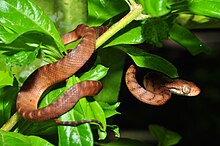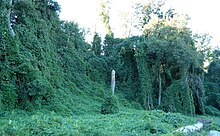
Invasive species are a crucial threat to many native habitats and species of the United States and a significant cost to agriculture, forestry, and recreation. An invasive species refers to an organism that is not native to a specific region and poses significant economic and environmental threats to its new habitat.[1] The term "invasive species" can also refer to feral species or introduced diseases. Some introduced species, such as the dandelion, do not cause significant economic or ecologic damage and are not widely considered as invasive. Economic damages associated with invasive species' effects and control costs are estimated at $120 billion per year.[2]
The main geomorphological impacts of invasive plants include bioconstruction and bioprotection.[3]

- ^ "Invasive Species". education.nationalgeographic.org. Retrieved 2024-04-06.
- ^ David Pimentel, Rodolfo Zuniga, Doug Morrison. Update on the environmental and economic costs associated with alien-invasive species in the United States. Ecological Economics. 52 (2005) 273-288.
- ^ "Invasive species", Wikipedia, 2024-03-21, retrieved 2024-03-30